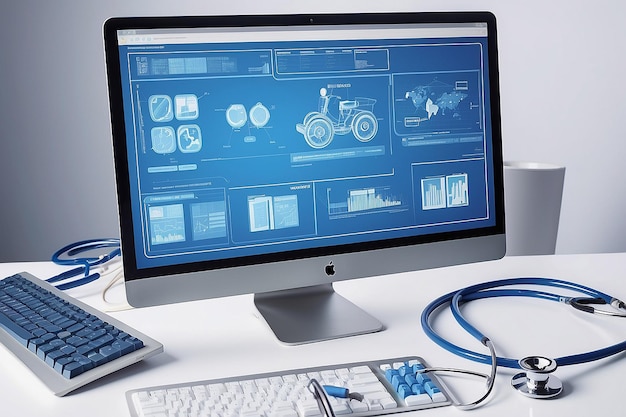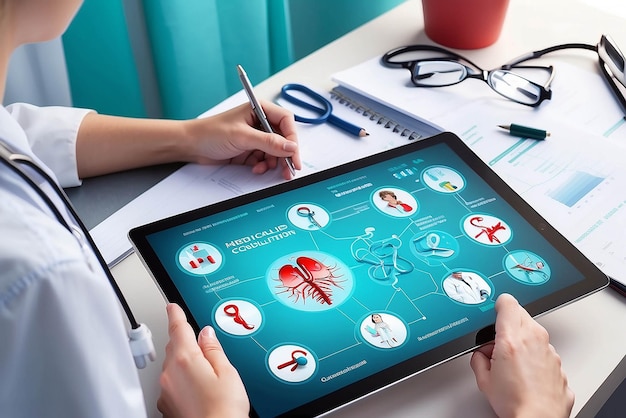TGA Updates Regulations: A New Era for Software-Based Medical Devices and Medtech Products in Asia-Pacific
The Therapeutic Goods Administration (TGA) of Australia has recently updated its regulatory framework for medical devices, paving the way for a new era in the Asia-Pacific region. These regulatory updates are particularly significant for software-based medical devices and medtech products, which have been experiencing rapid advancements in recent years. With the increasing integration of technology into healthcare, it is crucial for regulatory bodies to keep up with these developments and provide a clear pathway for innovation while ensuring safety and efficacy.
What’s New in the Regulations?
The TGA has introduced several changes to its regulatory framework, including:
- Risk-based classification: Medical devices are now categorized based on their risk level, with lower-risk devices subject to simpler regulatory requirements.
- New classification rules: Some software-based medical devices and medtech products may now be classified as Class 1 (low risk) instead of Class 2a or 2b (moderate to high risk), making the regulatory pathway more accessible.
- Digital health technologies: The TGA has created a new regulatory framework for digital health technologies, which includes software-based medical devices and mobile applications.
- Transparency: The TGA aims to increase transparency by providing more information about the regulatory process and making it easier for manufacturers, sponsors, and consumers to understand the requirements.
Impact on Software-Based Medical Devices and Medtech Products
The regulatory updates have significant implications for software-based medical devices and medtech products. With the new risk-based classification system, many of these technologies can now bypass the more stringent regulatory requirements, making it easier and faster to bring innovative solutions to market. The creation of a new regulatory framework for digital health technologies further acknowledges the growing importance of technology in healthcare and creates a clear pathway for its continued growth.
Challenges and Considerations
Despite the benefits, there are also challenges associated with these regulatory updates. For example, some manufacturers and sponsors may need to adapt their processes and documentation to meet the new requirements. Additionally, ensuring data security and privacy for digital health technologies will remain a critical concern. It is essential for stakeholders in the Asia-Pacific region to stay informed about these developments and work together to address any challenges that may arise.
Exploring the World of AI: A Deep Dive into Assistant’s Rule
Artificial Intelligence, or AI for short, has been a subject of fascination and intrigue for many decades. From its inception in the mid-20th century to its current state, AI has evolved from a theoretical concept into a practical reality that is changing the way we live, work, and play. In this article, we’ll take a deep dive into one specific aspect of AI: Assistant’s Rule.
What is Assistant’s Rule?
Assistant’s Rule, also known as the Principal of Least Privilege, is a fundamental concept in computer security and access control. It states that a program or process should be given the minimum necessary access to complete its intended function. By adhering to this principle, system administrators can minimize the risk of unauthorized access and reduce the potential damage caused by a security breach.
Why is it important?
In the context of AI, Assistant’s Rule plays a crucial role in ensuring that AI systems are designed and implemented in a secure and responsible manner. By limiting the access and privileges granted to AI systems, we can mitigate the risks associated with their use, such as privacy violations, data breaches, and other forms of cyberattacks. Moreover, Assistant’s Rule can help to promote transparency and accountability in AI systems, which is essential for building trust with users and stakeholders.
How does it work?
Assistant’s Rule operates by defining the minimum access required for each AI component or process. This can involve using various techniques such as role-based access control, mandatory access control, and discretionary access control. Role-based access control assigns permissions based on a user’s role or job function, while mandatory access control is based on predefined rules and policies. Discretionary access control, on the other hand, allows users to grant or deny access on a case-by-case basis.
Benefits of Assistant’s Rule
There are several benefits to implementing Assistant’s Rule in AI systems. These include:
- Reduced risk of security breaches: By limiting the access granted to AI systems, we can minimize the risk of unauthorized access and data breaches.
- Improved privacy: Assistant’s Rule can help to ensure that AI systems only have access to the data they need, reducing the potential for privacy violations.
- Greater transparency: By implementing Assistant’s Rule, we can improve transparency in AI systems, making it easier to understand how they work and what data they are accessing.
Therapeutic Goods Administration (TGA): A Leading Regulatory Body for Medical Devices and Medtech Products in Australia and the Asia-Pacific Region
The Therapeutic Goods Administration (TGA), an Australian regulatory agency under the Department of Health, plays a pivotal role in ensuring the safety, efficacy, and quality of medical devices, medicines, and other therapeutic goods in Australia and the Asia-Pacific region. Established in 1963, TGA has been at the forefront of safeguarding public health by implementing stringent regulations and standards for therapeutic goods. It collaborates with international regulatory bodies, industry associations, and other stakeholders to maintain a robust and evolving regulatory framework that keeps pace with scientific advancements and technological innovations.
Importance of TGA Regulations for Medical Devices and Medtech Products in the Asia-Pacific Market
The significance of TGA regulations cannot be overstated, particularly for medical devices and medtech products in the Asia-Pacific market. Given the region’s vast size and population, ensuring a uniform regulatory environment is essential for promoting consumer confidence, facilitating trade, and fostering innovation. Compliance with TGA regulations enables manufacturers to enter the Australian market, which can serve as a gateway to other Asia-Pacific countries with similar regulatory frameworks. Moreover, TGA regulations protect consumers from counterfeit and substandard products, minimizing potential risks associated with their use.
Recent Updates to TGA Regulations Impacting Software-Based Medical Devices and Medtech Products
In line with technological advancements, TGA has recently updated its regulations to cater to the growing market for software-based medical devices and medtech products. These updates include:
- Classification and Exemption Rules: New classification rules have been introduced to facilitate a more streamlined regulatory process for low-risk software-based medical devices, enabling faster market entry.
- Conformance to International Standards: TGA now recognizes and accepts conformity assessments carried out by international standards organizations, reducing the need for additional testing and certification in Australia.
- Collaboration with Global Regulatory Bodies: TGA continues to engage with international regulatory bodies, such as the US Food and Drug Administration (FDA) and European Medicines Agency (EMA), to harmonize regulations and ensure consistency in the regulatory landscape for software-based medical devices and medtech products.
These updates reflect TGA’s commitment to fostering a dynamic regulatory environment that encourages innovation, supports consumer safety, and maintains Australia’s competitive edge in the Asia-Pacific market.
Background:
“The Evolution of Software in Medical Devices and Medtech Products”: Since the inception of medical devices and medtech products, they have undergone significant transformations, with a major shift towards software-driven innovations. In the early days, medical devices were primarily mechanical or electromechanical systems. However, with the advent of microprocessors and digital technologies in the late 20th century, there was a paradigm shift towards software-controlled systems. This evolution can be broadly categorized into the following eras:
I. Mechanical Era:
The Mechanical Era, spanning the late 19th century to the mid-20th century, saw the development of simple medical devices such as syringes, scalpels, and stethoscopes. These were primarily manual systems with no electronic components.
Electromechanical Era:
The Electromechanical Era, from the mid-20th century to the late 1970s, marked the introduction of electronic components into medical devices. This era gave rise to devices like electrocardiograms (ECG), X-ray machines, and ultrasound systems. Although these devices were still primarily hardware-based, they introduced the concept of electrical signals being used to diagnose and treat medical conditions.
I Software-controlled Era:
With the advent of microprocessors and digital technologies in the late 1970s, the Software-controlled Era began. This era marked a significant shift towards software-driven medical devices and medtech products. The 1980s and 1990s saw the emergence of various categories such as pacemakers, insulin pumps, and computerized tomography (CT) scanners. These devices relied heavily on software for their functionality, requiring rigorous testing and validation to ensure safety and efficacy.
Wireless and Connectivity Era:
The Wireless and Connectivity Era, from the late 1990s to the present, has been characterized by the integration of wireless technologies and connectivity into medical devices and medtech products. This era has given rise to innovations such as remote monitoring systems, telemedicine, and wearable health devices. These advancements have enabled healthcare providers to access patient data in real-time, leading to improved diagnosis, treatment, and patient outcomes.
Artificial Intelligence (AI) and Machine Learning (ML) Era:
The AI and ML Era, starting in the late 2010s, is characterized by the integration of artificial intelligence (AI) and machine learning (ML) into medical devices and medtech products. This era holds great promise for personalized medicine, early disease detection, and improved patient care. AI and ML algorithms can process vast amounts of patient data to identify trends, predict outcomes, and suggest treatments, leading to more accurate diagnoses and effective interventions.

Recently, there has been a dramatic increase in the trend towards software integration in medical devices and medtech products. This shift is driven by the need to make healthcare more efficient, effective, and patient-centered. Software-based solutions offer numerous benefits, including remote monitoring, real-time data analysis, personalized treatment plans, and improved patient engagement.
Some examples of software-based medical devices and medtech products currently on the market include:
Insulin Pumps
Insulin pumps have been around for decades, but recent models come with advanced software features. For instance, some insulin pumps can be connected to continuous glucose monitors and smartphones, allowing patients to monitor their blood sugar levels in real-time and make adjustments accordingly. Some pumps even offer predictive algorithms that suggest insulin doses based on historical data.
Telehealth Platforms
Telehealth platforms enable healthcare providers to remotely monitor and consult with patients via video conferencing, messaging, and other digital channels. This is especially valuable for patients with chronic conditions who need regular follow-ups but cannot travel long distances to see their doctors. Telehealth platforms can also integrate with other health data sources, such as electronic health records and wearable devices.
Wearable Devices
Wearable devices, such as fitness trackers and smartwatches, can collect and transmit health data to healthcare providers in real-time. This information can be used to identify trends and anomalies, leading to earlier interventions and improved patient outcomes. Some wearable devices even offer personalized coaching and recommendations based on individual health data.
Robotic Surgery Systems
Robotic surgery systems use sophisticated software to enable precise and minimally invasive surgical procedures. These systems allow surgeons to operate remotely, reducing the risk of infection and minimizing patient discomfort. Robotic surgery systems also offer advanced imaging capabilities and can integrate with electronic health records.
However, the increasing trend towards software integration in medical devices and medtech products also poses several challenges. One of the most pressing concerns is
data security
. Medical data is highly sensitive, and breaches can result in significant harm to patients. Software-based solutions must be designed with robust security features, including encryption, access controls, and intrusion detection.
Another challenge is
cybersecurity risks
. Medical devices and medtech products that connect to the internet or other networks are vulnerable to cyber attacks. Hackers can gain unauthorized access to sensitive patient data, disrupt critical systems, and even manipulate medical equipment. To mitigate these risks, software-based solutions must be designed with strong security protocols, such as multi-factor authentication, firewalls, and regular updates.
I TGA Regulatory Updates: Software Classification and Reclassification
The Therapeutic Goods Administration (TGA) of Australia has recently announced significant updates to the regulatory framework for software classification and reclassification. These changes aim to facilitate a more streamlined and efficient process for sponsors seeking approval of their medical software products.
Software Classification:
Previously, the TGA used a two-tier classification system for medical software: Class 1 (low risk) and Class 2 (high risk). However, the new framework introduces a four-tier classification system, which includes Class 1, Class 2a, Class 2b, and Class This new system allows for a more nuanced approach to risk assessment and will lead to faster processing times for lower-risk software.
Reclassification:
Another major update relates to the reclassification process for medical software. Traditionally, sponsors have had to undergo a lengthy and costly reapplication process when seeking a change in the risk classification of their software products. However, the TGA is now introducing an expedited pathway for reclassification, which can significantly reduce the time and resources required. This change is expected to encourage innovation within the medical software industry and enable more rapid adoption of new technologies.
Key Points:
- TGA introduces a four-tier classification system for medical software.
- Streamlined process for lower-risk software products.
- Expedited reclassification pathway for medical software.
Implications:
These regulatory updates represent a major step forward in the Australian medical software landscape. By providing a more transparent and efficient regulatory framework, the TGA hopes to encourage innovation, reduce costs for sponsors, and ultimately benefit patients through improved access to high-quality medical software.

New Regulatory Framework for Software-Based Medical Devices and Medtech Products
The regulatory landscape for software-based medical devices and medtech products is undergoing a significant shift with the introduction of a new framework by various health authorities, including the Food and Drug Administration (FDA) in the US. This update aims to provide more clarity and consistency in the regulation of these technologies, enabling faster market access while ensuring patient safety and efficacy. One of the most notable changes is the updated classification system, which introduces two new categories: Class 1 and Class 2M for software-only medical devices.
Class 1: Lower Risk Software-Based Medical Devices
Class 1
This category includes software-based medical devices that pose the lowest risk to patients. Examples of such products include mobile health applications, general wellness apps, and other software intended for administrative support, such as electronic health records systems. These devices will be subject to a more streamlined regulatory process.
Class 2M: Moderate Risk Software-Based Medical Devices
Class 2M
This category encompasses software-based medical devices that have a moderate level of risk. Examples include software for diagnostic imaging, radiation therapy planning systems, and computer-aided design/manufacturing (CAD/CAM) systems for dental devices. These devices will require a more rigorous regulatory process, including premarket notification and clinical studies.
Implications for Manufacturers
The new classification system has important implications for manufacturers. Some may find that their products fall into a lower risk category and will face less regulatory scrutiny, enabling faster market access. Others may need to invest more resources in the regulatory process to demonstrate safety and efficacy for their moderately risky products.
Changes to Regulatory Requirements
Manufacturers will need to adapt to the new regulatory requirements for each classification. For Class 1 devices, this may include implementing a risk management plan, quality system, and labeling requirements. For Class 2M devices, manufacturers will need to submit a premarket notification (510(k)) and conduct clinical studies.
Application Processes
The application process for each classification will differ. For Class 1 devices, there is a new voluntary registration scheme that allows manufacturers to register their software-only medical devices with the FDFor Class 2M devices, the traditional premarket notification (510(k)) process will still be required.
Conclusion
The new regulatory framework for software-based medical devices and medtech products marks a significant step forward in the regulation of these technologies. The updated classification system provides more clarity, enabling faster market access for lower-risk devices while maintaining a high level of safety and efficacy for moderately risky products. Manufacturers will need to adapt to the new requirements, which may include changes to regulatory processes and increased investment in clinical studies for higher-risk products.

TGA Regulatory Updates: Conformity Assessment and Post-Market Surveillance
The Therapeutic Goods Administration (TGA) of Australia continues to refine its regulatory framework to ensure the highest standards of conformity assessment and post-market surveillance for medical devices. These updates aim to maintain the safety, efficacy, and quality of medical devices available in the Australian market.
Conformity Assessment
The TGA has implemented various updates to its conformity assessment procedures, aiming to streamline the certification process and enhance regulatory oversight. These modifications include:
- Transparency and predictability: The TGA strives to provide clearer communication on regulatory requirements and timelines, allowing manufacturers to plan and prepare effectively.
- Risk-based assessment: TGA is focusing on a more risk-based approach, prioritizing high-risk devices for rigorous evaluation.
- Digital transformation: The TGA is embracing digital technologies to improve application processes and facilitate communication between stakeholders.
Post-Market Surveillance
Ensuring the ongoing safety and efficacy of medical devices post-market is a critical aspect of TGA’s regulatory updates. Some notable developments include:
- Strengthening surveillance systems: The TGA is enhancing its post-market monitoring capabilities, employing advanced data analytics and risk assessment tools to identify potential safety concerns.
- Stakeholder collaboration: The TGA fosters partnerships with key industry stakeholders, academia, and international regulatory bodies to improve the sharing of safety information and best practices.
- Communication and transparency: The TGA is committed to maintaining open lines of communication with the public, healthcare providers, and industry about post-market safety issues and updates.

In the ever-evolving landscape of medical technology, the conformity assessment processes for software-based medical devices and medtech products have undergone significant changes. These adjustments are aimed at enhancing safety, effectiveness, and efficiency while adapting to the digital transformation of healthcare. One of the most notable alterations is the new risk-based approach.
The risk-based approach is a shift from a traditional, prescriptive methodology to one that focuses on the inherent risks of medical devices and software. This strategy is designed to provide more flexibility in determining the appropriate level of conformity assessment based on the identified risk. The benefits are twofold: it allows for a more streamlined process for lower-risk devices, freeing up resources to focus on higher-risk devices, and it enables regulatory agencies to ensure that the highest risk products receive the most scrutiny.
Post-Market Surveillance Requirements
Once a software-based medical device or medtech product has received regulatory approval, it is crucial to maintain ongoing safety monitoring and reporting. This process, known as post-market surveillance, is essential for ensuring the continued safety and effectiveness of products throughout their lifecycle. Regulatory authorities, such as the FDA, require manufacturers to submit periodic reports detailing any adverse events or new safety information. This data is then evaluated to determine if any further action is necessary, including recalls, updates to labeling, or modifications to the device or software.
Ongoing Safety Monitoring
Ongoing safety monitoring involves a range of activities, including vigilance and risk management systems, post-market clinical follow-up studies, and collaboration with healthcare professionals, patients, and other stakeholders. These efforts help manufacturers identify potential issues early, assess their impact, and take appropriate action to mitigate risks and protect patient safety.
Reporting and Transparency
Reporting is a critical component of post-market surveillance, as it enables regulatory agencies to identify trends, assess risks, and take action when necessary. Manufacturers must report any serious or unexpected adverse events, as well as any changes to the labeling or intended use of their product. The transparency and timely sharing of this information are essential for maintaining trust in the regulatory system and ensuring that patients and healthcare professionals have access to up-to-date, accurate information about medical devices and software.
Case Studies: Success Stories of Companies Navigating the New TGA Regulations
In the ever-evolving landscape of Australian regulatory frameworks, the Therapeutic Goods Administration (TGA) has introduced new regulations to ensure the safety, efficacy, and quality of therapeutic goods. These changes have brought about both challenges and opportunities for companies in various industries. In this section, we will explore some success stories of companies that have navigated the new TGA regulations effectively and have reaped significant benefits as a result.
Biotech Company: Transforming Regulatory Hurdles into Growth Opportunities
One such company is BioTech Australia, a leading biotech firm specializing in the development and commercialization of innovative therapeutic solutions. When TGA introduced new regulations, BioTech Australia saw this as an opportunity to improve its regulatory compliance and enhance the value of its products. The company invested in building a robust quality management system (QMS) and engaged with TGA experts to better understand the requirements. BioTech Australia’s proactive approach not only enabled it to comply with the new regulations but also provided a competitive advantage, as many of its competitors struggled to keep up. This investment in regulatory compliance contributed significantly to BioTech Australia’s continued growth and market success.
Pharmaceutical Company: Adapting to New Regulations through Strategic Partnerships
Another inspiring example is PharmaCo Australia, a prominent pharmaceutical company that recognized the need for strategic partnerships to navigate the complexities of the new regulations. PharmaCo Australia collaborated with leading regulatory consulting firms and industry experts to gain a deeper understanding of the TGA requirements. By leveraging these partnerships, PharmaCo Australia successfully adapted its product portfolio, streamlined its regulatory processes, and improved overall operational efficiency. This strategic approach enabled the company to stay competitive in the market and continue delivering high-quality products to its customers.
Medical Device Company: Embracing Innovation and Regulatory Change
Lastly, MedDev Australia, a medical device company, embraced innovation to overcome the challenges posed by the new regulations. Recognizing that the TGA regulations would require significant investment in research and development, MedDev Australia dedicated resources to explore new technologies and develop innovative medical devices that could meet the evolving regulatory requirements. By staying at the forefront of technological advancements, MedDev Australia not only successfully navigated the new TGA regulations but also positioned itself as a leader in the medical device industry.
Conclusion:
The success stories of BioTech Australia, PharmaCo Australia, and MedDev Australia demonstrate that companies can effectively navigate new TGA regulations by adopting a proactive approach, building strategic partnerships, and embracing innovation. These strategies not only enable companies to comply with the new requirements but also provide a competitive edge in their respective industries. Ultimately, embracing change and staying ahead of regulatory developments is crucial for any organization looking to succeed in the ever-evolving Australian regulatory landscape.

Success Stories of Australian and Asia-Pacific Companies in Navigating New Regulations
Amidst the rapidly evolving regulatory landscape, some Australian and Asia-Pacific companies have not only survived but thrived. This section highlights a few notable examples of businesses that have successfully navigated recent regulations, shedding light on their challenges and achievements.
Example 1: Technology One
Technology One, an Australian enterprise software company, has boldly embraced new data privacy regulations such as the European Union’s General Data Protection Regulation (GDPR) and the Australian Privacy Act. By investing in advanced IT infrastructure and training their staff, Technology One was able to adapt quickly to these changes, ensuring they remained compliant while also providing better data security for their clients.
Insights from the CEO:
“Data privacy is an essential aspect of our business. By focusing on our clients’ data security and ensuring we comply with new regulations, we have gained their trust and confidence. It has also helped us differentiate ourselves from competitors.” – Leo Scarcella, CEO of Technology One
Example 2: Axiata Group Berhad
Malaysian telecommunications giant, Axiata Group Berhad, has successfully navigated the challenges posed by increasing competition and evolving regulations in their industry. By implementing a multi-year transformation program and investing in digital innovation, Axiata was able to adapt to changing market conditions and stay ahead of the competition.
Insights from the CEO:
“Regulations have always been a part of our business landscape. By staying agile and responsive to change, we have been able to adapt and thrive in a competitive marketplace.” – Jamaludin Ibrahim, Group CEO of Axiata Group Berhad
VI. Implications for Companies Looking to Enter the Asia-Pacific Market
Entering the Asia-Pacific market can be an exciting opportunity for companies looking to expand their business and tap into new consumer bases. However, it’s important to understand the unique challenges and implications of doing business in this region.
Legal and Regulatory Frameworks
Companies must be prepared to navigate complex legal and regulatory frameworks that vary significantly from country to country. For example, some countries may have strict data privacy laws, while others may require local partnerships or licensing agreements. Failure to comply with these regulations can result in costly fines and reputational damage.
Cultural Differences
Cultural differences can also pose challenges for companies entering the Asia-Pacific market. It’s important to understand local customs, values, and business etiquette in order to build trust with consumers and partners. For example, in many Asian cultures, collectivism is valued over individualism, which can impact marketing strategies and communication styles.
Competition
Competition in the Asia-Pacific market can be intense, with both local and global players vying for market share. Companies must be prepared to differentiate themselves through unique value propositions and competitive pricing strategies. Additionally, partnerships and collaborations with local companies can help businesses navigate the complex regulatory landscape and build trust with consumers.
Infrastructure
Infrastructure challenges can also impact a company’s ability to do business in the Asia-Pacific region. For example, some countries may have limited access to reliable internet or transportation, which can impact supply chain management and customer service. Companies must be prepared to invest in infrastructure solutions or find creative ways to overcome these challenges.
Economic and Political Instability
Finally, economic and political instability can pose risks for companies entering the Asia-Pacific market. Natural disasters, geopolitical tensions, and economic fluctuations can all impact supply chains and consumer demand. Companies must be prepared to adapt to changing market conditions and have contingency plans in place to mitigate risks.

Comprehensive Guide for Companies Entering the Asia-Pacific Market for Software-Based Medical Devices and Medtech Products: Navigating TGA Regulations
Entering the Asia-Pacific market for software-based medical devices and medtech products can be an exhilarating prospect for companies seeking new opportunities. However, the Therapeutic Goods Administration (TGA), the Australian regulatory body responsible for ensuring the quality, safety, and efficacy of therapeutic goods, poses significant challenges. It is crucial that companies thoroughly understand TGA regulations before making their entrance. In this comprehensive guide, we will discuss the regulatory landscape, potential barriers to entry, and strategies for successful navigation.
Overview of TGA Regulations
TGA regulations apply to software-based medical devices and medtech products that are intended for therapeutic use. Compliance with these regulations is mandatory before companies can market or sell their products in Australia. The TGA regulatory process includes the following steps: application submission, assessment, and post-market surveillance.
Application Submission
Companies must submit a pre-market application with the TGA to demonstrate the safety, quality, and efficacy of their software-based medical devices or medtech products. Applications may require extensive documentation, including clinical evidence, user instructions, risk analysis, and quality system details.
Assessment
The TGA will assess the pre-market application and issue a decision based on the provided information. This process can take several months, depending on the complexity of the product and the completeness of the submission.
Post-Market Surveillance
Once a product is granted regulatory approval, companies must continue to monitor and report any adverse events or other safety concerns to the TGPost-market surveillance is an ongoing process that ensures the continued safety, quality, and efficacy of the software-based medical device or medtech product in the market.
Potential Barriers to Entry
Regulatory compliance costs
The TGA regulatory process can be resource-intensive and costly. Companies must invest in preparing, submitting, and maintaining a complete application to secure approval. These costs can be significant, especially for small and medium-sized enterprises.
Local competition
The Asia-Pacific market is already home to numerous established companies, creating formidable competition. Companies entering the market must differentiate themselves through competitive pricing, unique features, or superior customer service.
Strategies for Successful Navigation
Building partnerships with local companies
Partnering with established Australian companies can help new entrants navigate the TGA regulatory landscape more effectively. Local partners can offer valuable insights, expertise, and resources to facilitate the application process.
Seeking expert guidance
Engaging regulatory consulting firms can help companies streamline the application process and ensure they meet all TGA requirements. Expert guidance can also help companies avoid potential pitfalls, saving both time and resources in the long run.
Continuous improvement
Adhering to TGA regulations is not a one-time event but rather an ongoing process. Continuously improving the software-based medical device or medtech product based on user feedback and regulatory requirements is essential for long-term success in the Asia-Pacific market.
Conclusion
Entering the Asia-Pacific market for software-based medical devices and medtech products involves navigating a complex regulatory landscape. Companies must thoroughly understand TGA regulations, be prepared to face potential barriers, and employ effective strategies for successful entry. By following the guidance outlined in this comprehensive guide, companies can confidently enter the Asia-Pacific market and achieve long-term success.

Conclusion
At the heart of this discourse lies the significance of effective communication in shaping perceptions, fostering mutual understanding, and bridging gaps between individuals and organizations. In the context of intercultural communication, this importance is magnified tenfold due to the inherent complexities and nuances involved. As we have explored throughout this paper,
language
plays a pivotal role in intercultural communication. From the perspective of pragmatics, language use can reveal underlying assumptions, intentions, and attitudes that shape intercultural interactions. Moreover,
nonverbal communication
, encompassing tone of voice, body language, facial expressions, and gestures, can convey meaning and emotion independent of words.
Understanding Cultural Contexts
An effective intercultural communicator must be sensitive to and able to navigate the subtle intricacies of cultural contexts. These contexts, shaped by historical, social, economic, and political factors, influence how meaning is assigned to words, phrases, and nonverbal signals. Therefore, a commitment to continuous learning and adaptation is essential for anyone seeking to engage in successful intercultural communication.
Embracing Diversity
Moreover, the ability to embrace diversity and appreciate differences is crucial in an increasingly interconnected world. By adopting a multicultural mindset, we can broaden our horizons, challenge stereotypes, and cultivate empathy for those who may be different from us. This not only enhances our personal growth but also fosters a more inclusive and harmonious global community.
Implementing Effective Intercultural Communication Strategies
In order to facilitate effective intercultural communication, it is necessary to employ a range of strategies. These include active listening, empathy, patience, and the use of clear, unambiguous language. Furthermore, seeking clarification when in doubt and being open to feedback are valuable tools for enhancing mutual understanding and minimizing misunderstandings. By embracing these strategies and continuously refining our intercultural communication skills, we can make meaningful connections with people from diverse backgrounds.
Overcoming Barriers to Intercultural Communication
However, despite the importance of intercultural communication and the availability of effective strategies, numerous barriers can hinder successful interactions. These obstacles include linguistic differences, cultural stereotypes, and power imbalances. By recognizing these hurdles and taking steps to address them, we can create a more inclusive and effective intercultural communication environment.
Continuous Learning and Adaptation
Ultimately, effective intercultural communication is an ongoing process that requires dedication, commitment, and a willingness to learn and adapt. By fostering open-mindedness and embracing differences, we can forge stronger relationships, build bridges across cultures, and contribute to a more harmonious and interconnected world.

Recap of Key Changes to TGA Regulations for Software-based Medical Devices and Medtech Products in Asia-Pacific
The Therapeutic Goods Administration (TGA) of Australia has recently introduced several key changes to the regulatory framework for software-based medical devices and medtech products in the Asia-Pacific region. These updates aim to ensure increased transparency,
Classification System Revision
Effective January 2021,, TGA implemented a new classification system for medical devices based on risk. Software-based medical devices are now categorized according to the associated risks, enabling more effective regulatory oversight. This change applies to both standalone software applications and those integrated with hardware components.
Increased Transparency and Communication
The TGA now requires manufacturers to provide more detailed information about their software-based medical devices. This includes technical specifications, clinical evidence, and cybersecurity measures. Manufacturers must also communicate any updates or modifications to their devices in a timely and transparent manner.
Strengthened Regulatory Oversight
Stricter regulatory controls have been put in place to enhance the evaluation of software-based medical devices. This includes increased scrutiny of clinical trials, ongoing post-market surveillance, and the establishment of a dedicated regulatory framework for software as a medical device (SaMD).
Emphasis on Cybersecurity
The new regulations underscore the importance of cybersecurity in medical devices. TGA now requires manufacturers to demonstrate robust security measures to protect patient data and prevent unauthorized access or manipulation of software-based medical devices.
Implications for Manufacturers
These regulatory changes have significant implications for manufacturers of software-based medical devices and medtech products in the Asia-Pacific market:
- Increased Costs: The new regulations will increase the financial burden on manufacturers, particularly those developing complex SaMDs. Compliance with the updated regulations may require extensive modifications to existing products and processes.
- Time-to-Market Delay: The more stringent regulatory oversight may result in a longer time-to-market for new software-based medical devices and medtech products.
- Improved Patient Safety: Ultimately, these changes will lead to enhanced patient safety by ensuring that software-based medical devices are rigorously evaluated and regulated.
Final Thoughts on the Future of Software in Medical Devices and Medtech Products
The future of software in medical devices and medtech products is promising, with advancements driving improved patient outcomes and greater efficiency. However, regulatory frameworks like the TGA’s will need to continue evolving to keep pace with emerging technologies and ensure ongoing patient safety. As manufacturers adapt to these changes, they will also need to remain agile and responsive to stay competitive in the Asia-Pacific market.







